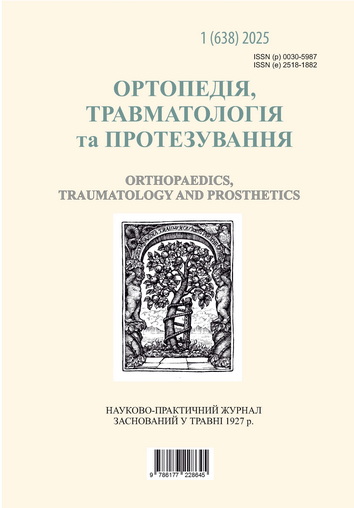MATHEMATICAL MODELING OF THE MUSCLES RESPONSIBLE FOR SHOULDER JOINT FLEXION IN UPPER OBSTETRIC PARALYSIS
DOI:
https://doi.org/10.15674/0030-59872025175-81Keywords:
Obstetric brachial plexus palsy, Erb-Duchenne syndrome, shoulder joint, joint moment, muscle strength, modelingAbstract
Objective. To determine the degree of change in muscle length and torque of the shoulder joint during flexion in conditions of the pathological position of the upper limb in Erb-Duchen syndrome. Methods. The analysis of the change in muscle length and torque of the shoulder joint was performed at flexion within 50°– 60°. In the Erb syndrome clinic, the torque value of the joint is reduced due to weakness or paralysis of the muscles that provide stability and mobility of the shoulder joint. Verification of the appearance of the model was carried out according to the 3D-model obtained from the CT scan of the patient. Results. After analyzing the work of the muscles responsible for the flexion of the shoulder joint, it was determined that a decrease in muscle strength leads to a decrease in the moment of force acting on the joint, a change in the length of the force lever affects the moment of force, a change in the angle between the force and the arm of the force leads to a decrease in the muscle's efficiency. Internal rotation of the humerus reduces the length of the muscle, which is demonstrated in the models. When lifting the arm with a load, the muscle shortens and its length decreases accordingly. Other muscles not represented in the model do not contribute to the generation of torque of the shoulder joint due to their lack of direct connection to the humerus, but they are responsible for the movement of the scapula and clavicle. A decrease in their strength, a change in the direction of the force vector leads to significant changes in the ratio of the anatomical structures of the shoulder girdle with high individual variability. Conclusions. A change in the direction of the force vector of a muscle and its length during bending lead to changes in motor activity: a decrease in the moment of the joint leads to a limitation of the amplitude of movements in the joint, the balance between different muscles acting on the joint is disturbed, it can lead to its instability and deformates. Biomechanical changes limit the functionality of the joint and cause pain syndrome. The identified biomechanical changes indicatethe need to correct the specified pathological conditions.
Downloads
How to Cite
Issue
Section
License
Copyright (c) 2025 Olena Karpinska, Anastasiia Hrytsenko

This work is licensed under a Creative Commons Attribution 4.0 International License.
The authors retain the right of authorship of their manuscript and pass the journal the right of the first publication of this article, which automatically become available from the date of publication under the terms of Creative Commons Attribution License, which allows others to freely distribute the published manuscript with mandatory linking to authors of the original research and the first publication of this one in this journal.
Authors have the right to enter into a separate supplemental agreement on the additional non-exclusive distribution of manuscript in the form in which it was published by the journal (i.e. to put work in electronic storage of an institution or publish as a part of the book) while maintaining the reference to the first publication of the manuscript in this journal.
The editorial policy of the journal allows authors and encourages manuscript accommodation online (i.e. in storage of an institution or on the personal websites) as before submission of the manuscript to the editorial office, and during its editorial processing because it contributes to productive scientific discussion and positively affects the efficiency and dynamics of the published manuscript citation (see The Effect of Open Access).














